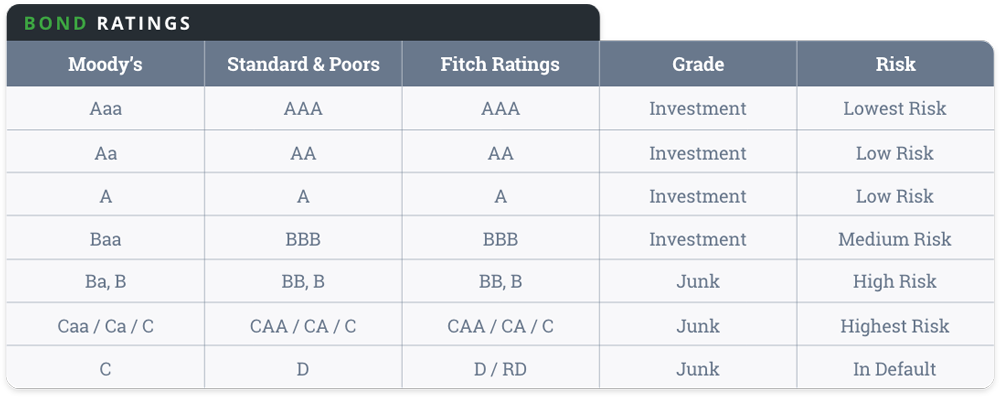Note: The information in this blog is for information purposes only and should not be used or construed as financial, investment, or tax advice by any individual. Information obtained from third parties is believed to be reliable, but no representations or warranty, expressed or implied is made by Questrade, Inc., its affiliates or any other person to its accuracy.
Lesson Fixed-income investments
Fixed Income and Bond ETFs
Learn more about fixed income and Bond ETFs and how they can work in your portfolio.
Exchange traded funds (ETFs) come in many different shapes and sizes, but are primarily organized by the type of Asset class or category.
In this article, we’ll focus primarily on Fixed Income and Bond ETFs, but you can learn more about different categories of ETFs here.
Remember: An ETF is simply a ‘basket of assets’, and can contain hundreds of different investments.
- ETFs can be bought or sold just like stocks
- You can buy ETFs commission-free with Questrade

Fixed income and Bond ETFs have a lot of similarities, primarily the ability to generate steady income or dividends. All Bond ETFs can be considered “fixed income” but not all fixed income ETFs are made up of Bonds exclusively. Instead they can be made up of preferred shares, or other steady income-generating investments.
In both cases, you can think of these ETFs as an alternative, or accompaniment to typical Equity (stock) based ETFs in your portfolio depending on your investing goals & risk tolerance.
Check out the section below for a deeper look at Bond ETFs, and skip to the next section for more information on Fixed-Income ETFs.
Please note: This article is for informational and educational purposes only. No information contained in this article is intended to provide any form of investment or financial advice.
Bond ETFs
Bond ETFs are primarily made up of Bonds, and can come in a few different varieties, notably:
Sovereign
Tracks, and is made up of bonds issued by the governments of sovereign countries. The benefit with these bond ETFs is the low probability of default in developed countries.
Emerging and developing markets may offer more competitive coupon, or ‘interest’ rates, but come with increased risk.
Common examples include:
- US Treasury Bonds
- Government of Canada Bonds
- European Central Bank Bonds
- Emerging market government Bonds
Corporate
Corporate bond ETFs hold the bonds issued by companies to raise money and finance their day-to-day operations or special projects. They usually offer higher returns than most sovereign bond ETFs, but come with some increased risk.
Corporate bonds are actually debentures, which is just a complex way of saying unsecured bonds. These bonds are not secured by any assets or physical property, instead they rely on the issuing company’s credit rating. (These credit or bond ratings are usually through Standard & Poor, Fitch, or Moody’s)
Generally speaking, higher rated bonds are considered to be lower risk, but will also pay lower amounts of interest.

Lower rated, or Junk Bond ETFs are also sometimes referred to as “High Yield” Corporate bond ETFs.
With the higher coupon payments or interest however comes increased default (bankruptcy) risk. If a company goes bankrupt, debtors (bondholders) would typically have a higher priority than shareholders to have their debts repaid; however with many junk bonds, the issuing company may have little to no assets left to settle their debts.
Municipal
Municipal bonds are technically a type of sovereign bond, but instead of being issued by the Federal Government, or Central Bank/Treasury, they’re issued by Province (or State), City, or even township/municipality.
Most municipal bonds only come in high denominations ($50,000+) which can be a barrier to some individual investors, and this is where municipal bond ETFs come in. Municipal bond ETFs are easier to purchase individually, and offer important diversification without investing significant sums.
Broad Market/Index
The most popular bond ETFs available tend to be broad market, or bond index ETFs. These ETFs package and combine various types of sovereign, corporate, and municipal bonds into one easy-to-buy ETF.
They are often called Aggregate bond ETFs, and can track the overall bond markets of different countries, or different segments of the bond market. Common examples include:
- Total Bond index ETFs that track the entire market
- Short-term bond index ETFs
- International bond index ETFs
- Canadian, or American aggregate bond ETFs
- High Yield Bond index ETFs

Fixed Income ETFs
Fixed income ETFs are a large category of ETFs primarily created to generate steady dividends, and can be made up of Bonds, Preferred equity shares (preferred stocks), Guaranteed Income Certificates (GICs), and other lower risk, income-generating assets.
The most popular types of fixed income ETFs are specifically Bond ETFs, but more ‘alternative’ types of fixed-income ETFs are becoming popular.
If you’re looking for more information on Bond ETFs specifically, check out the section above.
Preferred Share ETFs
Preferred shares, sometimes referred to as preferred stock, are a unique asset class. What sets preferred shares apart from their “common” share counterparts is their usually higher than average dividend yield.
Preferred shares can come in many different categories including: callable preferred shares, rate-reset preferred shares, convertible preferred shares, cumulative preferred shares, and various other types.
These preferred shares can be bought just like common shares through any Questrade platform, but you will need to pay close attention to the individual characteristics, dividend differences, and other entitlements of the shares.
Rather than trying to understand the minute details of each type of preferred share, some investors may buy ETFs that hold hundreds or thousands of preferred shares.
Important to remember: While preferred shares, and preferred share ETFs are considered to be lower risk than their common varieties, they are still subject to volatility and risk in the overall markets.
In the case of a company’s bankruptcy, debtholders (bonds) are paid out before preferred shareholders. This is because a preferred share is a type of equity security, whereas bonds are a debt security.
In terms of relative risk, generally-speaking Preferred share ETFs are riskier and more volatile than Bond ETFs.
(Some exceptions may apply, for example: High-yield or “junk” bond ETFs which carry increased risk compared to a “blue-chip” preferred share ETF.)
Tip: One benefit of preferred shares, and preferred share ETFs is their tax treatment in Canada in non-registered or Margin accounts.
While bond and bond ETFs payments (coupons) are counted as interest income, payments from preferred share ETFs are treated as dividends by the CRA.
This important difference in taxation rates can have significant implications for your portfolio, if you have questions we strongly recommend speaking with a tax professional.
Related lessons
Want to dive deeper?
Fixed income trading
Discover how to buy fixed income products like GICs and Bonds using the Questrade platforms.
View lessonRead next
Stocks 101
Learn about the basics of stocks, adjusted cost basis, and dividend paying securities.
View lessonExplore
Investing foundations
Understand the fundamentals and major concepts in investing to help you build a solid investing foundation.
View lesson